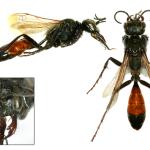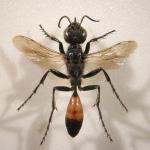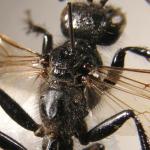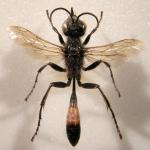A very local species, being mainly restricted to south-east England; there are also a few records from Dorset, Lincolnshire, South Yorkshire and Merseyside. In Ireland, it is found in coastal sites in Wicklow and Wexford. On the Channel Islands it is known from Herm (Luff, 1905b), Alderney, Guernsey, Sark and Jersey.
Listed as Rare (RDB3) in Shirt (1987) and Falk (1991). Recent work indicates that it may be more widespread than previously thought.
Most British sites are coastal (especially dunes); inland habitat invariably consists of dry heathland.
Females fly from the end of May to late September; males from late June to August.
Principally large noctuid caterpillars; sometimes the smaller larvae of the noctuid Eremobia ochroleuca ([D.& S.]) (Dusky Sallow).
Essentially very similar to that of Podalonia hirsuta (Scopoli) (Richards, 1980; Palmer & Stelfox, 1931; Olberg, 1959). Field (1993) found that females sometimes dig their burrows before prey capture (once five days before), and sometimes after, in the latter case leaving prey in a grass tuft during digging. The owner of one of the nests was seen stealing an Eremobia larva from an Ammophila sabulosa nest, and another Podalonia female opened a second Ammophila nest but found that it was empty. Prey was also stolen from two Podalonia nests, but the species of thief involved is unknown. Larvae in three of Field's nests provisioned in July spun cocoons which overwintered to produce females in the second half of June of the next year. Two others produced males in August of the same year as the provisioning, suggesting that there may be a partial second generation.
Bramble and hemlock water-dropwort, among others.
Podalonia nests are sometimes brood-parasitised by Ammophila species - the prey is not stolen, but, instead, the original egg is chewed off the prey and replaced with an Ammophila egg. Miltogrammine fly maggots (probably all Metopia species - one M. campestris (Fallén) was reared) had destroyed four to six of the eggs from 14 nests excavated by Field. In one bizarre case, a fly larviposited on to prey while it was left lying outside a nest during a long fight between two Podalonia females.
1998





